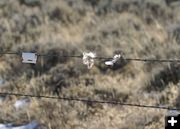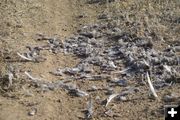

Bird collision
This photo shows grouse feathers stuck on a barbed wire fence, next to the markers used to reduce such collisions.
|


Collision aftermath
The sage grouse that hit the fence was quickly consumed by a predator, leaving only feathers.
Although not mentioned in the study, golden eagles and other birds of
prey have been known to drive sage grouse into fences and other structures to injure or kill them.
|
|
Sage grouse fence collision study
by Cat Urbigkit, Pinedale Online!
November 29, 2009
A two-page preliminary report of a study examining sage
grouse collisions with barbed wire fences has generated a
great deal of interest. The report, written by Tom Christiansen of the Wyoming Game and Fish Department, detailed the work to document such collisions in a study area that is believed to contain the greatest concentration of Greater Sage Grouse in the world - the Little Sandy country at the border of Sublette and Sweetwater counties.
Knowing that sage grouse collisions with fences have been
reported to cause grouse injury and death, Christiansen is
attempting to determine what can be done to reduce such
collisions. The issue is getting added attention from those
opposed to livestock grazing on public lands, which have
quickly latched onto the issue as another reason why such
use should end. In addition, the U.S. Fish and Wildlife
Service has a court-imposed February deadline to determine
if sage grouse should be protected under the Endangered
Species Act.
The study included interim recommendations, while research
continues:"Not every fence is a problem; those that tend to cause problems typically include one or more of the following characteristics:
1) constructed with steel t-posts,
2) are constructed near leks,
3) bisect winter concentration areas, and/or
4) border riparian areas.
"Areas of greater topographic relief (roughness) appear to have
lower incidence of collisions apparently because the birds have
to fly higher to avoid the ground.
"Avoid building fences within at least ¼ mile (preferably
0.6 mile) of leks. New and existing fences in these areas
should be surveyed for evidence of grouse fence strikes
before installing permanent fence markers.
"In brief, surveys can be conducted by walking, driving or riding slowly (2-3 mph) along the fence looking for carcasses or concentrations of feathers on the ground and individual feathers caught on top wire barbs. Evidence of fence strikes does not last long due to weather and scavengers. The discovery of fence strikes is therefore cause for mitigation. Where the decision has been made to mark a fence we currently recommend the top wire be marked with at least 2 markers of the Sutton design modified with high quality reflective tape. While we have yet to substantiate the need for reflective tape, untaped markers become essentially invisible with snow cover."
Arrangements are being made to make markers available
to ranchers at no cost. Contact WG&F's Tom Christiansen for further information at tom.christiansen@wgf.state.wy.us.
|

